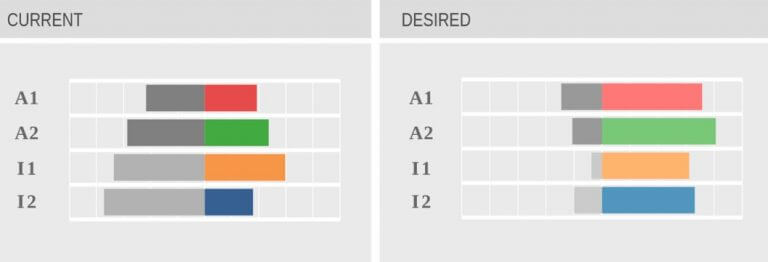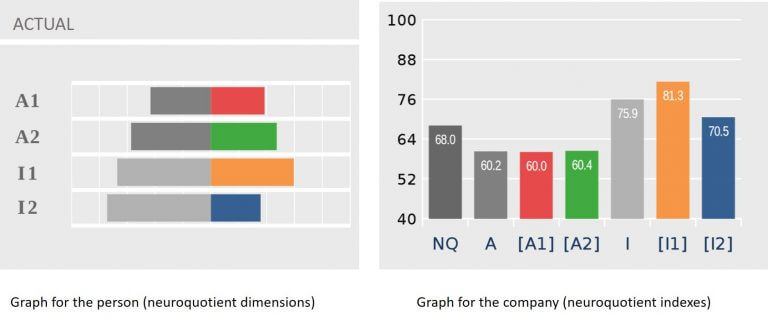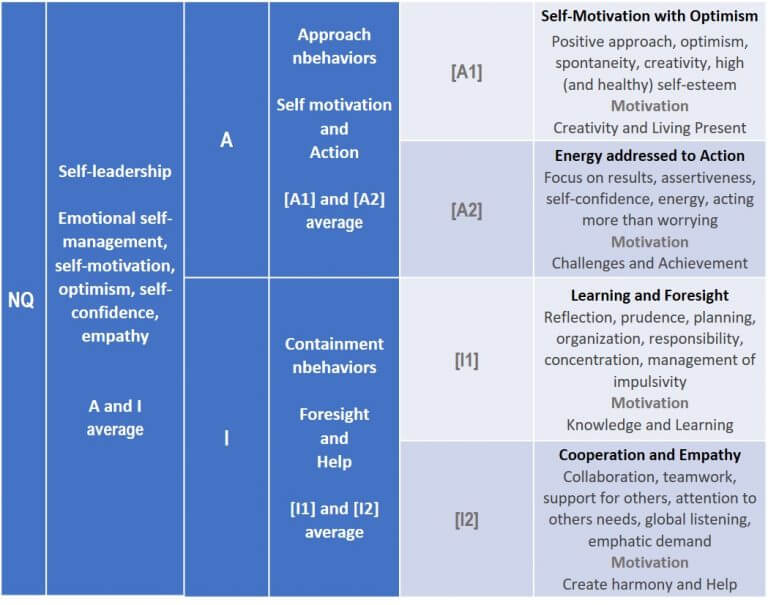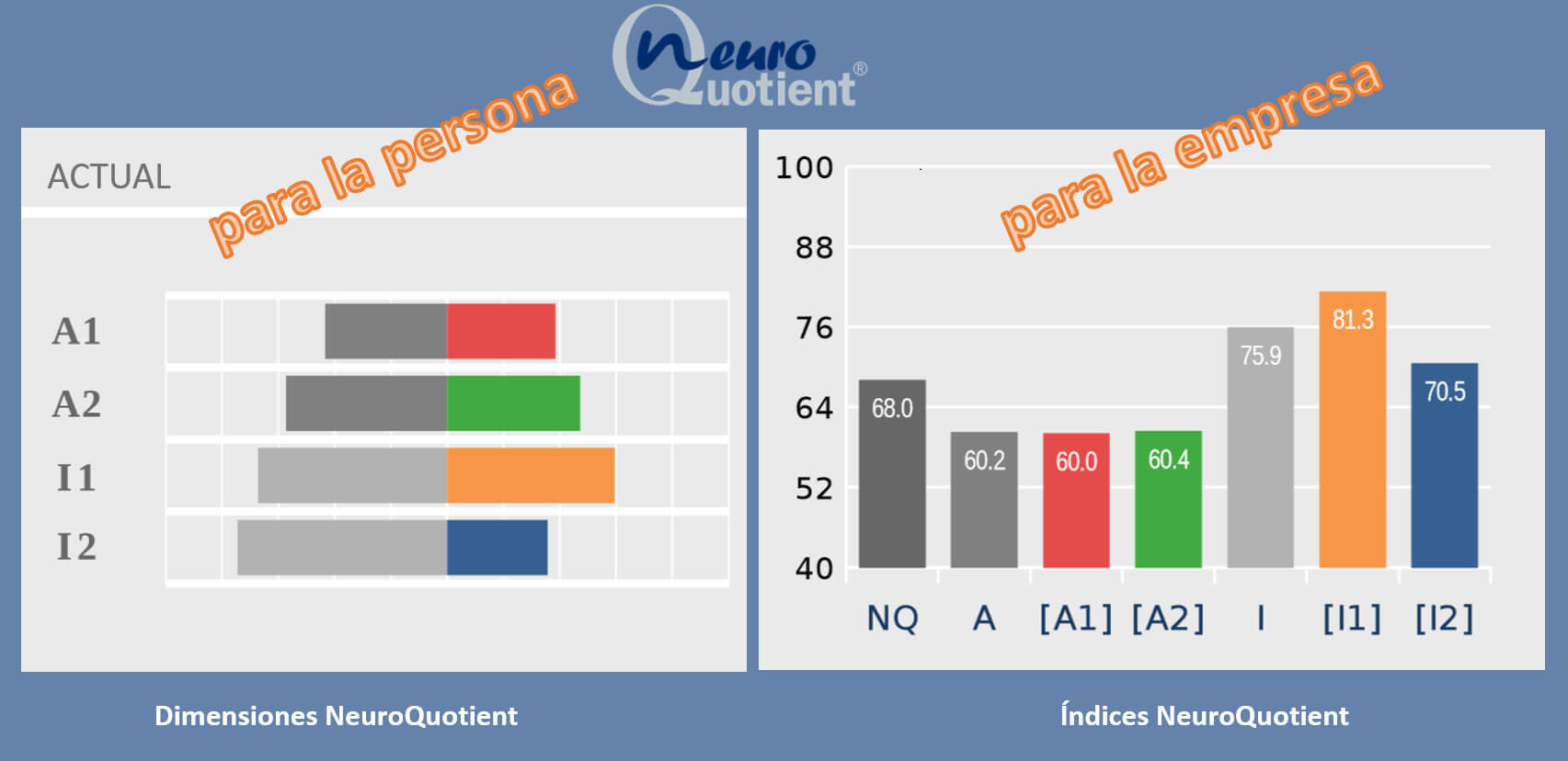Neuroscience in companies, applied to people development, is an important resource but not easy to be used. In this post we will see the value contribution of NeuroQuotient in the neuroleadership development. How it makes possible and practical the application of neuroscience in companies. The processes are more efficient, since it works on the self-leadership focusing on the priorities. In addition, it allows to measure progress.
Introduction
We listen to the contribution of neuroscience in companies for people development. More specifically for the neuroleadership. There are proposals for courses and workshops to do so. However, it is not easy. Above all, is difficult to demonstrate tangible results beyond the novelty.
Moreover, people who discover NeuroQuotient®, some of them through introductory webinars observe their possibilities and ask us,
Can NeuroQuotient® be used for the development of people, while applying neuroscience in companies and organizations?
They have become aware of the great power of the neuro tool for coaching and development. They understand that it can contribute too, to introduce neuroscience in companies and organizations. Converting the neuroleadership development into something tangible.
The answer is:
Of course, NeuroQuotient® is being used with great success to apply neuroscience in companies in the development of neuroleadership.
With this post we explain why so, by answering the following question:
What is the value contribution of NeuroQuotient®?
The answer is addressed to those responsible for the areas of people development. They will be able to see how to apply neuroscience in companies in a practical and tangible way. Also, it’s for the people certified in NeuroQuotient®, and to those who want to be certified.
We will start with a small Introduction to NeuroQuotient. But before, give us to introduce the two key differential elements with respect to other tools and development strategies.
- The processes are much more efficient.
- NeuroQuotient measures progress.
What is NeuroQuotient?
A tool to understand and apply neuroscience in a practical way to the people development
It is clear, that human behavior (understood in a broad way, including thinking and feeling) is based on brain patterns, supported by neural networks. Therefore, in NeuroQuotient, we are talking about neuro behaviors (nbhvrs, hereafter).
The NeuroQuotient explains in a simple way the brain bases of behavior. The neuro behaviors. In this way, it makes neuroscience practical.
On the other hand, the neuro tool (Fig. 1) helps us to measure the intensity of these neuro behaviors, differentiating between those that provide satisfaction (we call them efficiencies, and we graph them in color) and those that do not provide good results (limitations and we draw them in grey).
In addition, it has a development approach. The person asks himself where he is (current state) and about his desired state (Fig 1). People, as in the example (a real case), want to increase their efficiencies and reduce limitations.

Why is NeuroQuotient so powerful to apply neuroscience in companies and organizations?
Very Easy! Because Development processes are more efficient and productive, that is, they provide greater results in less time.
Due to two reasons, mainly:
- Works from self-leadership
- Helps to focus on the key points to improve results
Self-leadership or personal leadership
It is common for initial development goals to refer to more or less tangible competencies, but deep down, self-leadership always is underlying.
Usually, in the development processes, objectives are focused on tangible competences, for example:
Communication / Teamwork / Organization and Planning / Leadership
And, too many times, we intend to achieve them with training sessions that rarely serve much.
However, when it is addressed, even if only partially, with individual sessions, we find situations such as the following:
People who are asked (and want to) communicate better (for example, make more persuasive presentations) realize that they get nervous facing an audience. (neuro behaviors: being afraid to do it wrong, after fear comes stress, and the need to flee, and, later, only anticipating the situation, fear and stress are triggered).
Another example. Team work is no easy for who, apparently, have a great self-confidence, but focuse only on their interests and treats others with ‘aggressiveness’. (Ncomp: perceives others as a threat and, as in the previous case, their fear and stress systems are also active, but in the fight mode).
In both cases the key is ‘emotional self-management’, the self-confidence (well understood), the optimism, etc. Ultimately, the self-leadership.
With NeuroQuotient the person alone (it’s not a 360) answers the questionnaire. Next, in a climate of trust with the expert, becomes aware of the neuro behaviors that lead him/her to a greater satisfaction. Yes, greater satisfaction. The results that really count are emotional. And, the satisfied people (happy, why not) contribute more to the results of the company. Directly and indirectly, because they contribute to creating a more productive climate (collective emotional state).
Neuroscience in companies with the neuro tool enhances leadership. Self-leadership translated into positive influence (leadership) in others.
Focus on the most important. Prioritize.
It is quite common to use tools for the development of people that provide a lot of very good information. However, the person thinks: All this! Where do I begin?
NeuroQuotient, by comparing the current state with the desired one, helps identify what is a priority for development. It makes possible the Pareto principle: with 20% of shares, you get 80% of results.
With NeuroQuotient the person focuses on developing the priority to achieve a noticeable advance in their self-leadership. From there, to become a leader is easy.
And when someone reaches an adequate level of self-leadership it is easy to become a good leader. When they acquire an enough level of self-confidence, emotional self-management, etc., to lead is only to learn some techniques in training workshops.
Development with neuroscience in companies with the neuro tool is more productive, thanks to a greater focus. Pareto Principle, 80:20
A report for the person, another for the company.
NeuroQuotient provides different graphics and reports to the person and the company. To work in depth and maintain confidentiality with the person and inform the company accordingly.
At this point, everyone is already convinced that every process of leadership development had to include some individual sessions.
And here it is common for a problem to arise. For the process to be efficient, a great trust is necessary between the person and the coach or the consultant. This requires maintaining the confidentiality of what was discussed in the sessions. More with NeuroQuotient that can identify some ‘delicate’ issue in the limitations.
But the company ‘pays’ and wants, logically, to intervene in some way. The process can not be totally opaque for the company. Something must be transparent.
The NeuroQuotient solution is to use different graphs for the company. With some indexes in which the limitations are absorbed in the efficiencies (Fig2). Each efficiency absorbs a limitation of another level.

The most important NeuroQuotient index is NQ, which embraces all the efficiencies and limitations. It is higher when the efficiencies are higher and the lower the limitations.
NQ measures self-leadership!
We had it clear from the design of the tool. But, in addition, to confirm this, in the tool validation regarding TCI-R (Temperament and Character Inventory of Dr. Robert Cloninger), we found a very high correlation (0.69) with the Self-Directedness scale.
The other indixes, that at least embrace an efficacy and a limitation, can be seen in Table 1.
These graphs can be used both to state the individual development goals and, as we will see below, to demonstrate the results obtained.

Measure of progress,
The NeuroQuotient indexes allow measuring and demonstrating the progress in the processes of development.
But companies want to see justified their investment. They usually want to be shown improvement. For this, a qualitative report is not enough. However, quantifying progress is complicated. You can resort to 360 studies, but they are not very efficient.
There, is one of the most important contributions of NeuroQuotient. The neuro tool allows measuring progress.
Most of the tools that are used in development determine the personality through the behavioral traits.
NeuroQuotient does not deal with the personality. It is centered on the behavior and on the intensity of the neuro behaviors. In a coaching process of a few months the personality is impossible to be changed, but it is very feasible to adjust the behavior to improve the results.
Let’s continue with the example. Let’s see, Fig 3. the progress by comparing, with the graphs for the company, the current state at the beginning of the process and at the end of it. In this case the process lasted three months.

There is a progress in NQ, self-leadership and, mainly in the indices A, [A1] and [A2], those referring to neuro behaviors of approximation. Those who, in effect, the person was raised as priority improvement opportunities.
More than one will observe that the index [I1] – the highest at the beginning of the process – has decreased. This is totally consistent with the person’s purpose: he felt no need for improvement in dimension I1 (see Fig 1). Also, it is consistent with the model: a high efficiency points to the risk that the limitation of the same level is also. Efficiencies and Limitations are like two sides of the same coin.
Finally, write down a topic for a future article of interest to the company.
Prevention of psychosocial risks. Resilience is a particular case of self-leadership.
Self-leadership affects all the people in the company, not only those who have dependents.
The prevention of psychosocial risks is usually addressed from the point of view of the company so that people feel less negative effects.
It is rarely considered from the point of view of helping people to be more resilient. Or to work with those who ‘expelling their stress outward’ emotionally contaminate the environment.
But, let’s leave it for another article.
At the beginning we said that we wanted to present the contribution of the neuro tool in the practical and efficient application of neuroscience in companies and organizations. We hope this has been achieved.


